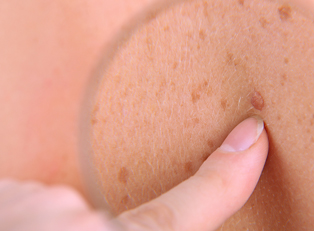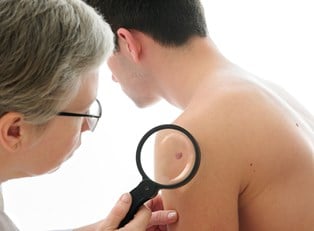Melanoma is a particularly dangerous form of skin cancer that originates within skin pigment cells, often due to overexposure to UV rays. In the past 30 years, the rates of this disease have increased dramatically, and for this reason it’s important to understand how melanoma develops and what can be done about it. Here is a quick overview of this deadly condition, including important statistics, symptoms, risk factors, stages, and treatments.
Melanoma Statistics
Every year about 76,000 people in the United States are diagnosed with melanoma, and another 9,700 die from the disease. While the risk of developing this form of cancer is relatively low for everyone, white people are about 20 times more susceptible to it than black people and about four times more susceptible than Hispanic people. The average age of diagnosis is 61, but it’s becoming increasingly common for cases to develop earlier in life, due in large part to the rise in popularity of tanning beds. When detected early, the survival rate for melanoma is quite high—around 95%. However, the prognosis for late-stage melanoma is much worse, with only about a 15% rate.
Melanoma Symptoms
Most forms of melanoma are easy to detect visibly, since they normally begin as abnormal-looking moles on the face, arms, back, or legs. When diagnosing the condition, doctors look for five specific characteristics that create the pneumonic device, ABCDE:
- Asymmetry: Melanomas are typically asymmetrical, meaning that one side of the mole is not a mirror image of the other.
- Border: The border of a melanoma will not be well-defined and may appear ragged or bumpy. On the other hand, healthy moles will have smooth, round borders.
- Color: A healthy mole will be one uniform color—typically either black or brown. Melanomas will be multicolored and may contain shades of red, white, or blue.
- Diameter: If a mole is wider than 6 millimeters (about the size of pencil eraser), there is a higher risk that it is cancerous.
- Evolution: A melanoma will typically change in size, shape, and color as it progresses.
Melanoma Risk Factors
People with fair skin and a family history of melanoma are at a higher risk of developing the condition than others. Additionally, excess exposure to UV radiation can also put you at risk. For this reason, it’s best to avoid tanning beds entirely and always wear sunblock when exposed to the sun for long periods of time. Finally, living at high elevations or near the equator puts you at a higher risk, since these areas are more directly exposed to UV rays.
Melanoma Stages
Melanoma is broken down into five stages of classification. Stage 0 is the earliest and easiest to treat—at this point, the melanoma hasn’t moved below the epidermis layer of the skin. In stage I, the melanoma has moved beyond the epidermis, but is still small enough that it hasn’t spread further. Stage II melanoma is between one and four millimeters thick and may have moved into nearby lymph nodes. In stage III, the melanoma moves into nearby lymph nodes and may cause new tumors near the original site to appear. Finally, in stage IV the cancer spreads to other organs. By this point, the cancer is very difficult to treat and recovery is unlikely.
Melanoma Treatments
Melanoma is treated with a combination of surgery, chemotherapy, radiation, and immunotherapy. In the early stages of the disease, most melanomas can be easily extracted and cause no further problems. However, if the cancer spreads to the lymph nodes and beyond, radiation and chemotherapy may be necessary. In the middle stages of melanoma, doctors may also recommend immunotherapy, which is medication that stimulates the patient’s immune system to attack the cancer itself.





